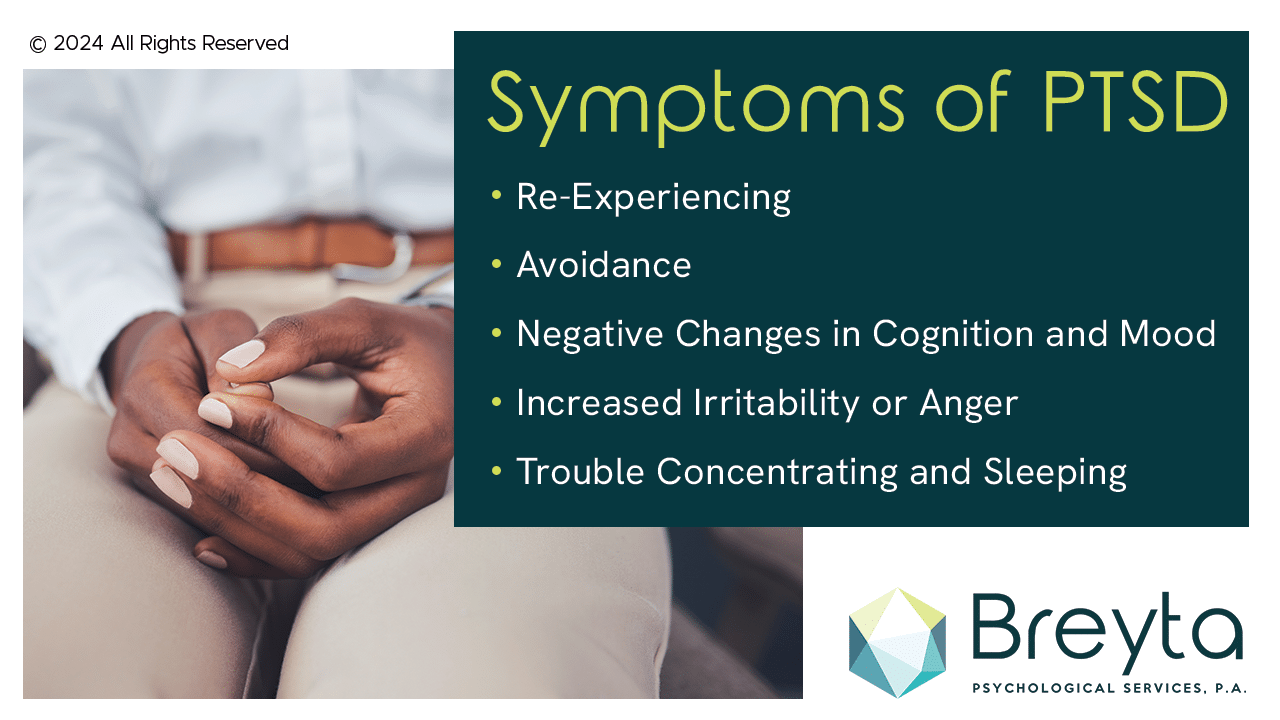Post-Traumatic Stress Disorder (PTSD) is a widespread condition that can develop after experiencing a traumatic event.
Though similar in name, PTSD is entirely different from trauma.
Trauma is a natural emotional reaction to a distressing event, such as physical danger, emotional abuse, or witnessing something horrific. Someone experiencing trauma may feel shock, fear, sadness, anger, or other traumatic stress reactions. Though unpleasant, these emotions tend to ease and fade over time.
PTSD is a mental health condition that can develop after a traumatic event. Those experiencing PTSD may struggle with intrusive thoughts, flashbacks to the event, and nightmares. They may take extreme measures to avoid anything that reminds them of the traumatic experience — or may become emotionally detached and hyper-vigilant, have difficulty sleeping, and develop other symptoms that significantly impair their daily lives.
Dr. Vanessa H. Roddenberry, Ph.D., HSP-P, Executive Director, and founder of Breyta Psychological Services in Raleigh North Carolina, shares her expertise on PTSD, its symptoms, how it can be treated, and how PTSD symptoms can be managed day-to-day.
If you’re experiencing symptoms of PTSD, we can help. Connect with Breyta Psychological Services today and start healing.

How Common is PTSD?
“PTSD is a huge, very prevalent problem all over the world, but especially in the U. S. right now,” says Dr. Roddenberry.
Recent research suggests that roughly 70% of people will experience severe trauma in their lifetime.
An estimated 20% of those who experience severe trauma will develop PTSD symptomology. That’s 14% of the overall population.
The true number of people with PTSD is probably much higher. Some people will attribute symptoms to something other than PTSD, and others won’t report them at all.
Dr. Roddenberry says, “This is not a new problem, but fortunately, we’re becoming more aware of just how prevalent it is.”
What are the Symptoms of PTSD?
“PTSD is a normal reaction to an abnormal event,” says Dr. Roddenberry. “It’s your body’s alarm system, and something gets in the way that prevents calming back down or recalibrating.”
PTSD symptoms are signs that your body is having difficulty processing something that you didn’t think could happen or be possible in your life. Your psyche is struggling to make sense of an abnormal experience.
The core symptoms of PTSD include:
- Re-experiencing: Flashbacks, nightmares, and intrusive thoughts about the traumatic event.
- Avoidance: Avoiding people, places, or situations associated with the trauma. This can lead to a shrinking social circle and difficulty maintaining healthy relationships.”Avoidance is what we call the glue of PTSD,” says Dr. Roddenberry. “If you’re avoiding dealing with the memories or reminders of the event, it’s going to make it hard for your mind to process what happened and make it make sense.”
- Negative changes in cognition and mood: Feeling down about yourself or others, difficulty feeling positive emotions, and feeling numb.
- Increased irritability or anger: Becoming easily angered or frustrated.
Dr. Roddenberry says one telltale sign is “getting feedback from the people in your social circles that you seem tightly strung or easy to anger.” - Trouble concentrating and sleeping: Difficulty focusing and hypervigilance leading to disrupted sleep. In Dr. Roddenberry’s experience, this is often because “you feel like you’re wired and on all the time and you want to be ready for things.”
Our systems can try to process things in different ways. So there can be a wide variation in symptoms. “This can look different for each person,” says Dr. Roddenberry. “PTSD symptoms might present themselves in different intensities, different patterns, and clusters.”
Treatment Options for PTSD
Effective treatment for PTSD involves well-researched, evidence-based therapies.
“At Breyta, we use guidelines recommended by the VA, DOD, and the American Psychological Association (APA) that tell us what treatments are most effective at addressing PTSD,” affirms Dr. Roddenberry.
Modalities mental health professionals use for PTSD treatment include:
- Cognitive Processing Therapy (CPT), a type of trauma-focused cognitive therapy, is one of the most evidence-based and effective treatments for Post-Traumatic Stress Disorder (PTSD). It helps identify negative thinking patterns related to your trauma and develop healthier coping mechanisms. “When you go through a traumatic event, we find that our thinking changes in specific ways,” notes Dr. Roddenberry. “We can have negative thoughts about ourselves or other people or the world.”
CPT can be delivered in a traditional format, or an intensive format with multiple sessions per week. Dr. Roddenberry says “CPT can be adjusted to fit your treatment needs and is still effective.”
When undergoing CPT for PTSD treatment, a therapist will work with you to identify specific negative thoughts and beliefs associated with the initial trauma. They will help you challenge their validity by considering the evidence against their accuracy. Your therapist will guide you through exploring more helpful alternatives to those thoughts and beliefs. - Prolonged Exposure Therapy (PE) is also supported by an extensive evidence base. It involves gradually exposing yourself to memories and situations associated with the trauma in a safe and controlled environment.
Exposure can be done by imaginal exposure, creating a detailed narrative account of the initial traumatic event which focuses on the sights, sounds, smells, and thoughts you experienced. Or through in-vivo exposure, which gradually exposes you to situations or places you’ve avoided due to their connection with the initial trauma.
“A lot of people have a fear about facing their trauma,” claims Dr. Roddenberry. “They think, will this make it worse? Can I handle it? But the answer is always yes – you can, and you will. Addressing the traumatic event doesn’t make it worse – quite the opposite actually, as avoidance just causes more problems and reinforces the idea that you can’t handle facing the memory.”
With either option, your therapist will guide you through the process at a pace you feel comfortable with.
Daily Management of PTSD Symptoms
“Coping with PTSD and recovering is about much more than just therapy,” says Dr. Roddenberry.
There are several things you can do to manage your PTSD symptoms in everyday life. Most are simple techniques that can be done anywhere, even with limited time.
“You don’t have to take a class in healthy coping skills,” notes Dr. Roddenberry. “But we can incorporate these skills, so you’ll be able to use them and have them in your tool belt when you’re outside of the therapy room.”
Some of the most effective things you can do to help manage PTSD symptoms are:
- Prioritize sleep: Getting enough quality sleep is crucial for overall health and well-being, including managing PTSD symptoms.
- Connect with loved ones: Social support is essential for healing from trauma.
According to Dr. Roddenberry “Keeping our loved ones along with us through the therapy journey can be immensely supportive.” - Practice mindfulness: Mindfulness techniques like deep breathing and focusing on the present moment can help manage stress and anxiety.
“Mindfulness is something that lets you change your relationship to your emotions,” says Dr. Roddenberry. “It helps you stay in the present.” - Learn grounding techniques: Grounding techniques like the “three things I hear, feel, and see” exercise can help you stay present and manage emotional distress.
For example, you might hear traffic outside your window. You might see birds outside. You might feel your body sitting in your chair, or the texture of your clothing. Notice those things, and describe them to yourself.
“What you want to do is utilize sensory data to force your mind and body to engage with the present moment,” says Dr. Roddenberry. “The richer a description you can give yourself, the more your body will interact with the present.”
Hope for Healing
Dr. Roddenberry reminds us that, “trauma has been around for as long as people have been around to experience it.”
Thankfully, due to extensive research, improved therapies, and a better understanding of how our systems process traumatic events, PTSD has become a treatable condition.
Evidence-based treatments like Cognitive Processing Therapy (CPT) and Prolonged Exposure Therapy, (PE) have been proven to significantly reduce PTSD symptoms. Under the care of a qualified mental health professional, these treatments are highly effective.
Research shows conclusively that our brains have remarkable neuroplasticity. With effective treatment, our brains develop new neural pathways to reduce the impact of traumatic memories and increase our resilience.
Overcoming PTSD is a healing process, and healing takes time. There will be breakthroughs and setbacks as you progress.
But with the right care and support, you can heal and live a fulfilling life.
We can help you find your way forward. Start your journey with Breyta Psychological Services today.

